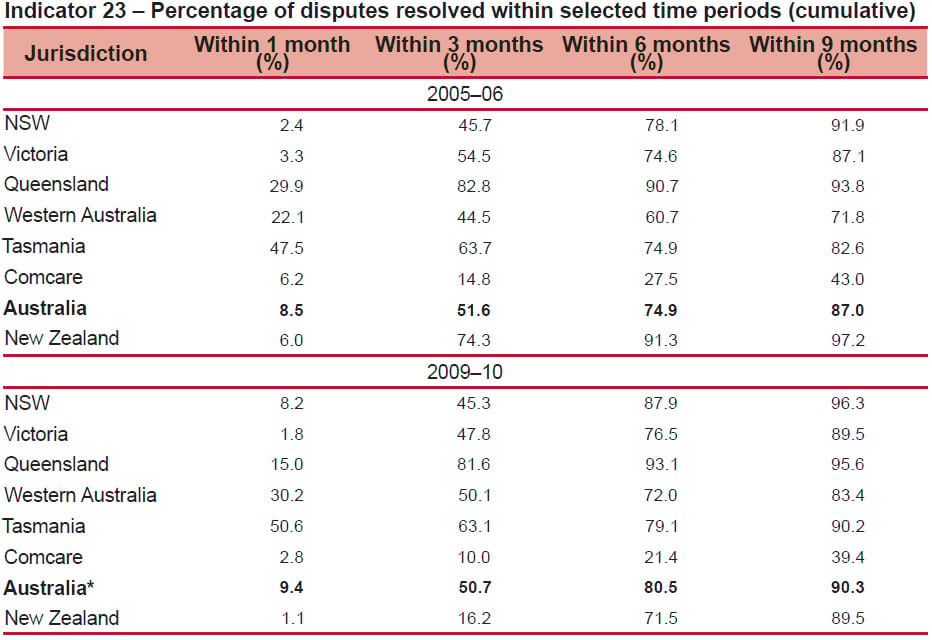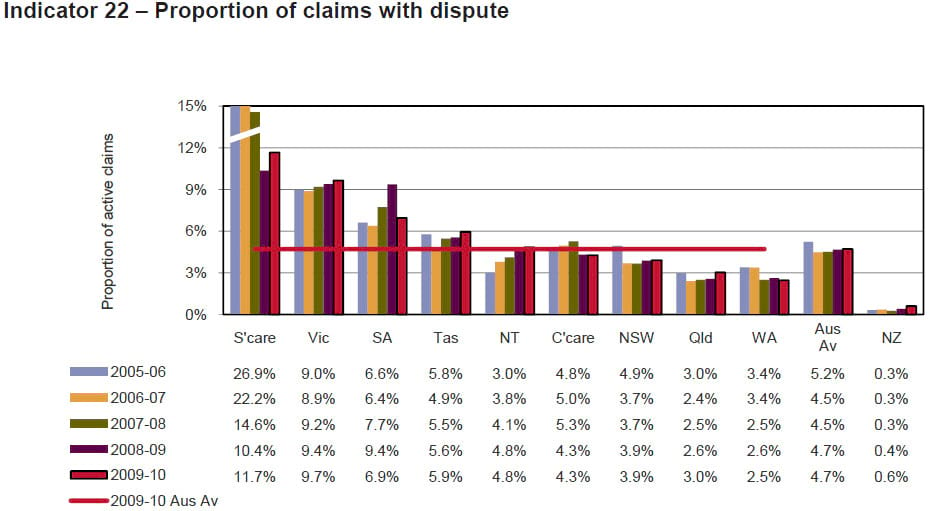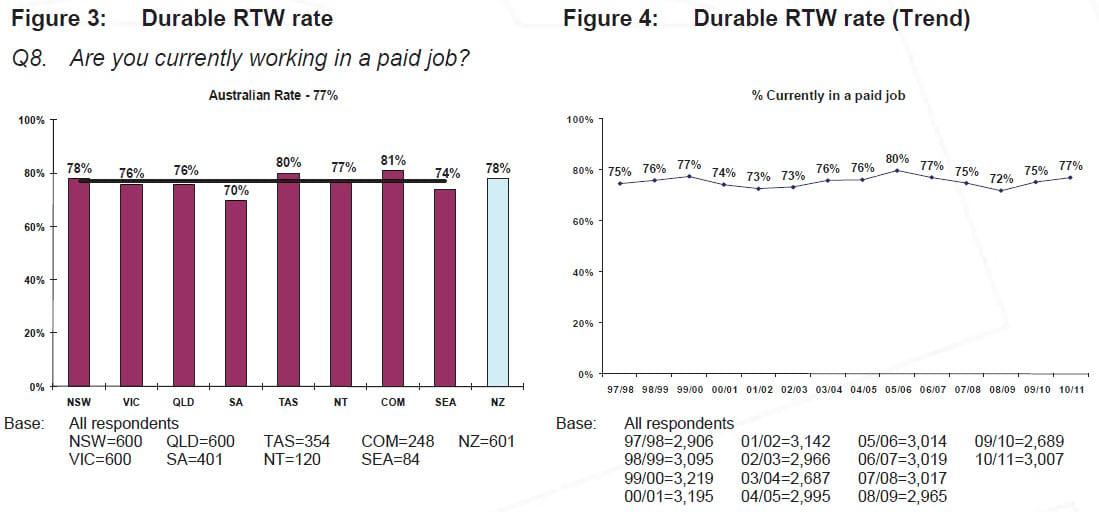Consider the alternative: Part 7 - Tasmania

New to this series on the use of dispute resolution in workers' compensation disputes? Previous articles in this series include:
- Part 1 – An Introduction to Alternative Dispute Resolution
- Part 2 – What makes a good workers' comp system with Nerida Wallace, Principal of Transformation Management
- Part 3 – Victoria
- Part 4 – New South Wales with Sian Leathem, Registrar of the NSW Workers Compensation Commission
- Part 5 - Queensland with Elizabeth Woods, CEO of Q-COMP
- Part 6 - Western Australia with WorkCover WA
WORKERS' COMPENSATION IN TASMANIA - BY THE NUMBERS
Tasmania resolves the highest percentage of disputes within one month in Australia and is home to the nation's highest durable return to work rate.
Resolution Rates

Data taken from Workplace Relations Minister's Council Comparative Performance Monitoring Report (October 2011) (p. 38)
At 50.6%, Tasmania’s rate of resolution within one month was by far the highest in the country (next highest was Western Australia at 30.2%). As a testament to the sometimes misleading nature of statistics, the result is not one Tasmania is proud of. The one month figures have been attributed to a culture of common law settlement of disputes, one that the State government is trying to address through legislative changes (more on that later).
Disputation Rate

Table from the 2009-2010 Comparative Performance Monitoring Report (p. 37)
Tasmania’s 2009-10- disputation rate of 5.9% was comfortably above the national average of 4.7%, and sat in the middle of the jurisdictions with high disputation rates ( Victoria 9.7%, South Australia 6.9%%), and those with low disputation rates (Western Australia 2.5%, Queensland 3.0%).
Durable Return To Work Rate

Table from the Heads of Workers' Compensation Authorities RTW Monitor 2010/11 (p. 2)
In 2010-11, Tasmania’s durable return to work rate of 80% was higher than any other State or Territory, and was 3% above the national average of 77%.
HOW THEY ARE MAKING IT BETTER
Issues with the previous system – culture of lump sum settlements
Although Tasmania’s one month resolution rates suggest that around half of all claimants were enjoying speedy resolutions, according to Mr Carey this was largely due to a culture of common law settlements that was detracting from the quality of outcomes.
Mr Carey noted that while “it was always said that the Tasmanian system was very efficient at resolving matters, it wasn’t in the spirit of the legislation that parties could settle at common law...The intent was to rehabilitate, re-train and return people to work, so reaching a lump-sum settlement without any of that endeavour didn’t seem to be in that spirit.”
This issue has been developing in Tasmania for several years, sparking a growing concern “that those who were middle-aged and had little future capability of returning to the workforce were settling for 40 or 50 thousand dollars, and we had no control over that.” According to Mr Carey, “that’s why the legislation was changed, to place legislative limits on your ability to do that."Reform to workers’ compensation in Tasmania (in effect from 1 July 2010)
On 1 July, 2010 the Workers Rehabilitation and Compensation Amendment Act 2009 came into effect and made significant changes to the law governing workers’ compensation disputes in Tasmania.
According to a summary of the changes provided by Workplace Standards Tasmania, the changes followed “a major review of workers rehabilitation and compensation and consultation with employers, workers, insurers, unions and industry groups.” The reforms are said to “provide for early intervention and a team-based approach to help with an injured worker’s treatment, recovery and return to work.”
Key changes include:
Increased scrutiny of settlements of workers’ compensation claims
- The legislation now disallows any settlement of the dispute within two years of the date of the claim without express approval by the Tribunal. According to Workplace Standards Tasmania “this will make settlements more transparent and ensure all reasonable rehabilitation, return to work and retraining options have been exhausted before a settlement is considered.
- When assessing a settlement, the Tribunal is required to consider whether:
- all reasonable steps have been taken to facilitate the worker's rehabilitation;
- the worker has received independent financial and/or legal advice paid for by the employer; and
- the settlement is in the best interests of the worker (source 2010 WRCT Annual Report p. 6)
Reduced threshold to allow seriously injured workers to pursue common law damages
- Whole person permanent impairment threshold reduced from 30% to 20%.
A more comprehensive system of injury management
- To improve the return to work culture among employers, workers and other stakeholders.
- According to Mr Carey, this “provides a lot of support for workers in that initial period, that 84 day period when an employer can accept or dispute a claim.”
THE ROAD AHEAD
With the amendments just over a year old, it might be too early to assess their impact, but the early signs are promising. “We have seen a drop in substantial disputes (that is those that come back to us as a major dispute on liability,” Mr Carey said. “I suspect our general level of disputes overall (even though the statistics don’t support it) have dropped, which is obviously a very good outcome.”
In line with a major focus of the reform, conciliation will not be able to be used as it has been in the past. “We were having 70 or 80% of matters resolving at conciliation because you could do a lump sum settlement for injuries. After 1 July 2010 you can’t do that, so conciliation is a lot more confined in how you may be able to resolve a matter because you can no longer talk about a common law settlement unless the parties want to go away and refer a settlement to the Tribunal as a separate matter.”
THE BOTTOM LINE
Tasmania has gone through an exhaustive process of identifying problems and implementing changes, and now waits to see what impact this will have on outcomes. But with a re-dedication to the quality of resolutions and the introduction of a comprehensive injury management system, things are certainly looking up, down in Tasmania.

